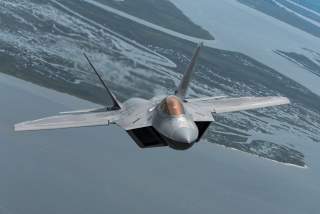The F-22 Raptor Has One Problem That Won't Ever Be Solved
No more can be built. Why?
The time and money needed to develop and build a new F-22s would take money away from PCA and other Air Force program that are more relevant to the 2030 fight. Even an export version of the F-22—should one have been developed—would have used up scarce resources. “The costs to restart production of the F-22 would be extensive even with the involvement of foreign partners,” the report states. “Just as F-22 production would compete for fiscal and contractor resources with other Air Force programs, any F-22 export would compete with FMS customers' resources as well, including countries already committed to F-35 purchases. Most nations are not likely to have the resources available for procurement of an export F-22, which extremely limits the ability of FMS to reduce the costs associated with restarting production.”
A 2017 Pentagon report to Congress detailing production retail costs for Lockheed Martin’s F-22 Raptor show that reviving the powerful stealth air superiority fighter would be prohibitively expensive. Moreover, it would take so long to reconstitute the production line that it would not be until the mid to late 2020s before the first “new” F-22s would have flown. By that time, the F-22 would be increasingly challenged by enemy—Russian and Chinese—capabilities.
(This first appeared last year.)
“The timeline associated with pursuing F-22 production restart would see new F-22 deliveries starting in the mid-to-late 2020s,” the Air Force report to Congress reads. “While the F-22 continues to remain the premier air superiority solution against the current threat, new production deliveries would start at a point where the F-22' s capabilities will begin to be challenged by the advancing threats in the 2030 and beyond timeframe. F-22 production re-sta1t would also directly compete against the resources necessary to pursue the Chief of Staff of the Air Force-signed Air Superiority 2030 (AS 2030) Enterprise Capability Collaboration Team (ECCT) Flight Plan, which addresses the critical capabilities required to persist, survive, and be lethal in the rapidly evolving-highly-contested Anti-Access/Area-Denial (A2/AD) threat-environment.”
Recommended: 5 Worst Guns Ever Made.
Recommended: The World’s Most Secretive Nuclear Weapons Program.
Recommended: The Fatal Flaw That Could Take Down an F-22 or F-35.
As the Air Force explained in the report, the aging F-22 design will not be competitive against an evolving threat as nations like Russia and China continue to invest in new technologies. “Moving closer to 2030, it is important to acknowledge that threat capabilities have and will continue to evolve at a rapid rate, creating highly contested environments,” the report reads. “The threat drives what capabilities are needed to achieve air superiority in the future, and the rate of threat evolution drives the timelines for the needed capability. Therefore, a conversation regarding restarting the F-22 production line should include an analysis of what capability and capacity is needed in order to achieve air superiority in future highly contested environments. An understanding of the threat along with necessary capability development will help provide an understanding of how restarting F-22 production will not fulfill capacity and capability requirements in the future.”
Thus, the Air Force needs to move ahead with its Penetrating Counter Air (PCA) program. “The Air Force should proceed with a formal AoA in 2017 for a PCA capability,” the report reads. “Consistent with an agile acquisition mindset designed to deliver the right capability on the required timeline, this AoA will include options to leverage rapid development and prototyping in order to keep ahead of the threat.”
An F-22 restart would not take five years minimum, but it would also be expensive. “Assuming a buy of 194 aircraft, the total procurement cost is estimated to be between $40 and $42 billion (BY16$),” the report reads. “When the total procurement cost is combined with the non-recurring restart estimated costs of $9,869 million (BY16$), the total restart cost is estimated to be $50,306 million (BY16$).”
The time and money needed to develop and build a new F-22s would take money away from PCA and other Air Force program that are more relevant to the 2030 fight. Even an export version of the F-22—should one have been developed—would have used up scarce resources. “The costs to restart production of the F-22 would be extensive even with the involvement of foreign partners,” the report states. “Just as F-22 production would compete for fiscal and contractor resources with other Air Force programs, any F-22 export would compete with FMS customers' resources as well, including countries already committed to F-35 purchases. Most nations are not likely to have the resources available for procurement of an export F-22, which extremely limits the ability of FMS to reduce the costs associated with restarting production.”
Moreover, the Air Force can no longer afford to develop a new aircraft in the same manner it developed the F-22 or F-35. Doing so would concede the technological high ground to Russia and China. “Developing and delivering air superiority for the highly contested environment in 2030 requires a multi-domain focus on capabilities and capacity,” the report states. “Importantly, the rapidly changing operational environment means the Air Force can no longer afford to develop weapon systems on the linear acquisition and development timelines using traditional approaches. Air superiority capability development requires adaptable, affordable, and agile processes with increasing collaboration between S&T, acquisition, requirements, and industry professionals. Failure to adopt agile acquisition approaches is not an option. The traditional approach guarantees adversary cycles will outpace U.S. development, resulting in ‘late-to-need’ delivery of critical warfighting capabilities and technologically superior adversary forces.”
Image: U.S. Department of Defense

